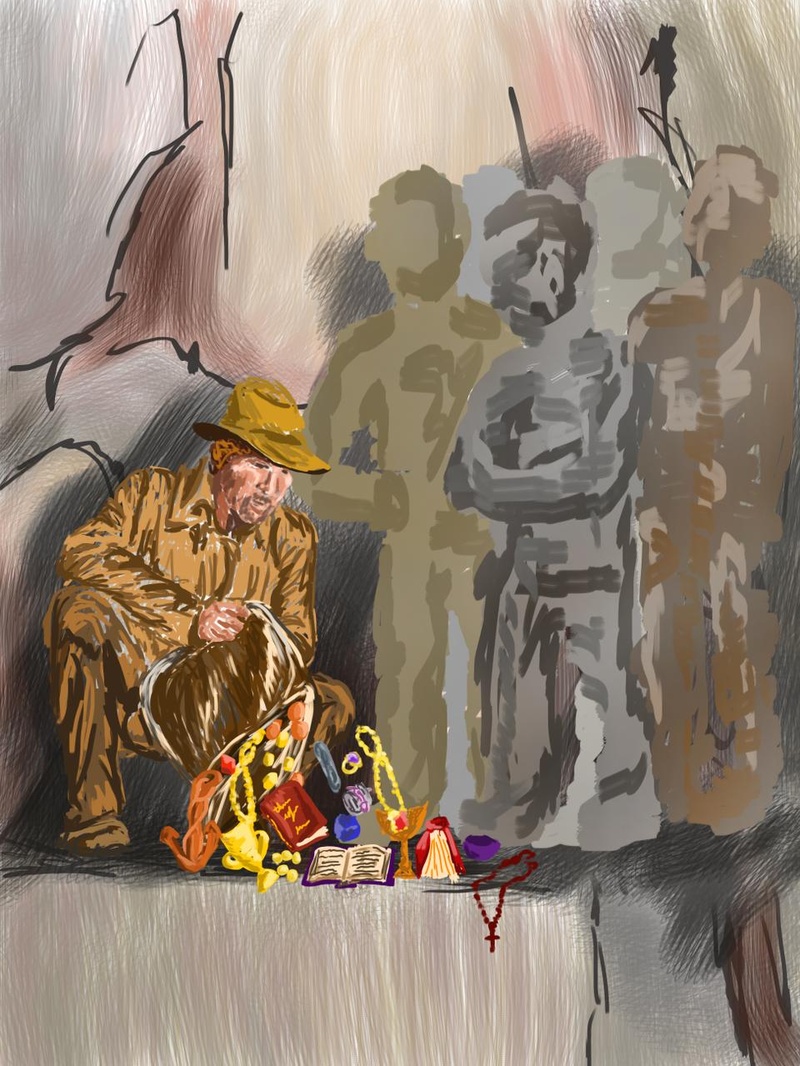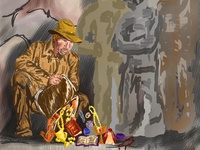Climbing the curved stone staircase and entering the hushed marble foyer of the Houghton Library is like entering an ancestral monument. In contrast to the teeming Lamont Library just across the lawn, Houghton’s expansive ceilings and furtive hallways are serene. Stepping through its doors, one can sense the range of history that is locked in cabinets just beyond reach.
Houghton’s current exhibition, which opened last week, pays homage to the scientific drawings of Edward Lear at the bicentennial celebration of his birth. In my childhood, I knew this British poet and artist as the man who wrote “The Owl and the Pussycat” and whose nonsensical drawings decorated the tiles around our kitchen sink. Yet this latest exhibition put on by Houghton celebrates the side of the man often forgotten: his talent for painting scientific images of animals, particularly life-like drawings of parrots and birds.
This wondrously extensive collection reflects the life-long obsessions of notable collectors Philip Hofer and William B. Osgood Field. But how the exhibition should be appreciated is less than straightforward. Can we consider the collection of Lear’s scientific drawings—not the components but the assemblage—a work of art in and of itself?
The opening of the exhibition also coincided with the Philip Hofer Prize for Collecting Books or Art, a prize that raises further questions about the merits of collecting. The private collector is often attacked for hiding works of artistic and historical value, and the inherent costs of collecting restrict its participants to a select few. The Lear show reflects the obsession, rigor, and knowledge of two private collectors, yet presents Lear’s works in a public forum so that the greatest number of people might also view the preserved artwork. Visibility presents a possible solution to the moral problem with collecting.
CHANCE AND COMPASS
Whether collecting is an art form or not, it evokes a passion in collectors that can rival that of artists. On Dec. 7, 1984, William P. Barlow Jr.—a well-known collector specializing in books printed by 18th century English printer John Baskerville—gave the ninth of the Engelhard Lectures on the Book at the Library of Congress that was entitled “Book Collecting: Personal Rewards and Public Benefits.” Beginning his talk, Barlow stated, “The collecting experience, it has always seemed to me, is so personal that it is both painful to write about and impossible to communicate.” These words almost resemble the sentiment of artists or writers when they are asked to discuss how they produce art. The act of creation is something difficult to communicate or express—much like Barlow’s inability to discuss the act of collecting—precisely because it is too “personal.”
Barlow goes on to discuss the process whereby a collector pieces together a collection. It begins—as all works of art—with chance. Barlow, already the owner of a printing press at age 16, read about 18th century printer John Baskerville in a book. It was then, while in Pasadena during his freshman year at college, that Barlow stumbled across a set of Milton’s works printed by Baskerville. This stroke of luck was the conception of his collection—a collection that has come to span his life.
Barlow’s experience in Pasadena mirrors the chance finding described by William Kentridge in the second of his Norton Lecture series “A Brief History of Colonial Revolts”; Kentridge showed a brief clip from his black-and-white comic opera “The Magic Flute” in which a man with spindly legs walks across the screen. Kentridge described how the image of the man came about purely because a pair of mathematical compass legs were lying on a surface of his studio. The chance finding of this compass thus gave rise to the artistic image on the screen—much like the chance finding of an object that might give rise to a collection.
Hope Mayo, the curator of the Department of Visual and Graphic Arts at Houghton, emphasizes that a collection is not a mere accumulation of objects. “A collection might begin with an accumulation, but it must then cohere in either form or subject. The collection is more than just an accumulation,” says Mayo.
The Philip Hofer Prize for Collecting Books or Art, which is given in the name of the founder of the Department ofPrinting and Graphic Arts, emphasizes the coherence of a collection over the rarity and cost of the pieces within it. A body of items must be unified and, by being an assemblage, reflect a meaning different from the individual pieces. In this sense, the collection comes to reflect a work of art: a work of art is a composition, a piecing together of various fragments to construct something unified and different to its individual parts.
PRIVATE EYES
The invention of printing press by Johannes Gutenberg in 1440 can be conceived as the beginning of modernity because the printing press allowed the material spread of knowledge in a way that was previously unfathomable. The mass production of books has altered the way in which art and books are now consumed. Particularly in an age of mass media, where information is freely available via the Internet, art and books are sometimes considered public property. Indeed, it could be argued that in order for art’s potential to be fully acknowledged, it must be seen, used and studied by as wide an audience as possible.
Yet privacy plays an integral role in collecting. A private collection can be considered elitist by the very nature of its privacy since its objects can only be appreciated by a select few. Yet, the importance of the private collector is evinced by the fact that the collections of public institutions—including Houghton Library—are composed, for the large part, of individual donations. As illustrated by the lives of both Barlowe and Philip Hofer, the eccentricity, obsession, and passion of the private collector is key to amassing a comprehensive collection.
The split between private and public ownership of valuable objects is a difficult boundary to chart. The lack of an audience potentially renders collecting a matter of recreation rather than a display of handicraft. But, more importantly, collecting raises a series of moral dilemmas.
COINING THE MARKET
Read more in Arts
Chabon’s Fiction Finds Homelands in ExileRecommended Articles
-
Folk ImplosionIn good old American-Gothic kind of families, a new child was welcomed into the family with a quilt. Mom needlepointed
-
Misusing FundsSILVER CITY, N.M.--John H. Snedeker, former president of Western New Mexico University, has recently been found guilty in state court
-
Undergrads Rewarded for Book CollectionsThree undergraduates who have amassed large literary collections—books on old-time radio, major tomes of Western philosophy and a 1920s-era novel
-
15 Books in FM's Lamont-Worthy CollectionEach year, three lucky Harvard students cash in big—in the most unlikely of ways. The Visiting Committee Prize for Undergraduate ...
-
Lin '10 Left Off All-Star RosterLast year, it took some work, but eventually Jeremy Lin ’10 made the Rookie-Sophomore Challenge at the 2012 All-Star Weekend. ...
-
 "Revenge" Served Cold, Overly Symbolic
"Revenge" Served Cold, Overly Symbolic















